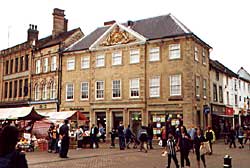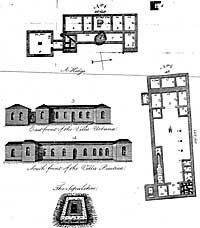

The Moot Hall in the Market Place, was built for Lady Oxford in 1752 (photo: Andrew Nicholson).
Structual
Standing buildings
Apart from the parish church of Sts Peter & Paul the town is unable to lay claim to any pre Tudor structures. This may be partly due to two fires in 1531 and 1546, which destroyed a total of 281 bays of buildings, which would have been a substantial portion of the town. Soon after these fires much building work commenced using stone. However great swathes of these buildings have been demolished to enable slum clearance, and to make way for new developments such as the market expansion of the 1820s, the construction of the Four Seasons shopping centre and the town’s inner ring road in the latter part of the twentieth century.
The town is not totally devoid of pre Victorian buildings with over 75 such structures within a 300-metre radius of the market place. These include such buildings as the late sixteenth century Cromwell house on Westgate and a series of fine but altered Georgian town houses along the same road and leading onto Church Street. The market place boasts a fine Regency Town Hall and Georgian Moot Hall. While just off of Stockwell Gate the counties oldest nonconformist church can be found; dating back to 1702 with its parsonage predating this by up to 100 years. The town also boasts England’s oldest railway viaduct.
Basic resources include pastscape.english-heritage.org.uk , www.imagesofengland.org.uk and the Nottinghamshire County Council’s Historic Buildings Record: www.nottscc.gov.uk/home/environment/heritage/heritage_listings/historicbuildingsrecord.htm. Local resources include the Buxton collection of paintings (see Graphic section) and numerous photographs (see Graphic section). The Nottinghamshire Archive Office has a substantial collection of deeds relating too many of these buildings.

Plans of Mansfield Woodhouse Roman villa, uncovered in the 1780s.
Ruins and Earthworks
Several interesting features surround the town such Hamilton Hill and King John's Palace, Clipstone. The County Council’s Sites & Monuments Record will provide an overview of such works along with pastscape.english-heritage.org.uk.
Archaeological Remains
The most well known being that of the Roman Villa uncovered by Major Rooke. Other finds indicate settlements in the area for thousands of years. The County Council’s Sites & Monuments Record will provide an overview of these remains along with pastscape.english-heritage.org.uk.
Landscape
The landscape around Mansfield tells many stories relating to its structural and industrial heritage the prime examples being the remains of the coal mining industry reflected in the landscaped spoil heaps, numerous mill lakes and water courses. The ancient layout of the parish is reflected in street names. The main study outlining the town’s landscape is that of J.R.G.Jennings, Mansfield, The Evolution of an Urban landscape 1863-1963 (University of Nottingham PhD thesis, 1966).